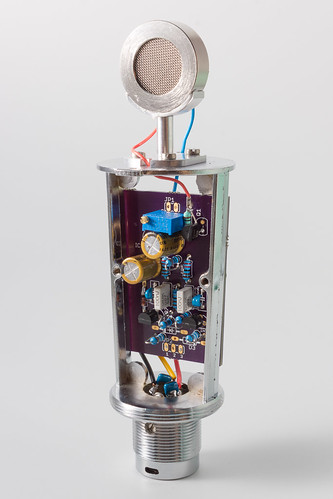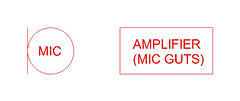Advice for setting up a studio at home
Apr 25, 2017 1:48:19 GMT -8
duffyweber and cbdroege like this
Post by benedict on Apr 25, 2017 1:48:19 GMT -8
Razzle, the "Ford vs. 4-wheel drive" is a good way to look at it.
I can take a stab at a longer explanation. If anyone sees any errors or points of confusion, please let me know so I can fix it.
At its most basic, a microphone consists of a sound sensitive element and enough electronics to boost the output so it can travel down a wire without loosing too much signal.
Unfortunately the word "amplifier" or "amp" gets used a lot when talking about microphones. At this point we're still talking about stuff that lives inside the microphone, and is usually hidden from view. You only see these bits if you take the microphone apart.

At the other end of the wire you need another amplifier to boost the signal from the microphone so it can be fed into your recording equipment.Since we're trying to record to a computer we need two other pieces of equipment: an interface to digitize the microphone's amplified signal, and a computer to record the output of the interface.
Almost any computer recording setup is going to have these five components. How they're arranged and where they live depends on how they're packaged.
In the case of a USB microphone, everything but the computer is wrapped up into one device. Sound goes in one end and a USB cable comes out the other. Examples of this are the Blue Snowball, the Blue Yeti, and the Audio Technica AT2020USB, though there are many more.
In the case of an XLR microphone the mic and amplifier are one device, and the preamp and interface are a separate device. Examples of XLR mics include the Audio Technica AT2020 (the non-USB version), the CAD E100S, the Shure SM7B, and a whole host of other mics. Examples of interfaces include the Focusrite Scarlett 2i2, the Steinberg UR22, and the PreSonus AudioBox USB, though again, there's a good selection out there.
So why use an XLR mic at all if it just complicates things? A lot of it comes down to flexibility. Unlike the AT2020, not every microphone is available as a USB mic, so it opens up the possibility of using a wider range of microphones. Another way it adds flexibility is that if you're recording very loud or very quiet sources, you can add other devices like an attenuation pad (which reduces output) or another preamp (which increases output) to the chain to help handle the difference in levels.

All of which comes with added cost and complexity, which is something to keep in mind when starting out. (Actually, it's something to keep in mind at every stage.)
The rest of the difference between microphones comes down to that first bit in the chain: the sound sensitive element. There's more than one way to turn pressure waves in the air into an electrical signal, so there's more than one kind of microphone.
The dynamic microphone uses a diaphragm to move a coil along a magnet. (It's basically a speaker in reverse.) Air pressure causes the diaphragm to move, which causes the coil to move through the magnetic field, which causes current to flow through the coil. This produces the electrical signal that gets passed down the chain to the computer. Some classic dynamic voice mics are the ElectroVoice RE20, the Shure SM7B, and the Shure SM57.
The condenser microphone uses a diaphragm that's closely spaced against a back plate. One is held at a low voltage and the other at a higher voltage. As air pressure strikes the diaphragm and moves it closer to or farther away from the back plate, the whole thing acts like a variable capacitor. The amplifier in a condenser microphone uses this to produce an electrical signal that gets passed down the chain to the computer. Some examples of condenser mics are the Neumann U87, the Rode NT1A, and the Octava MK-012.
The ribbon microphone uses a corrugated metal ribbon placed between two strong magnets. As air pressure strikes the corrugated ribbon, it moves through the magnetic field which causes current to flow through it. This produces the electrical signal that gets passed down the chain to the computer. Some examples of ribbon mics are the AEA R84, the Rode NTR, and the classic RCA 44.
There's no one right way to turn sound into an electrical signal. Each one of these has its own characteristic sound and its own limitations. And each one can be found as an XLR microphone or as a USB microphone.
I can take a stab at a longer explanation. If anyone sees any errors or points of confusion, please let me know so I can fix it.
At its most basic, a microphone consists of a sound sensitive element and enough electronics to boost the output so it can travel down a wire without loosing too much signal.
Unfortunately the word "amplifier" or "amp" gets used a lot when talking about microphones. At this point we're still talking about stuff that lives inside the microphone, and is usually hidden from view. You only see these bits if you take the microphone apart.

At the other end of the wire you need another amplifier to boost the signal from the microphone so it can be fed into your recording equipment.
Almost any computer recording setup is going to have these five components. How they're arranged and where they live depends on how they're packaged.
In the case of a USB microphone, everything but the computer is wrapped up into one device. Sound goes in one end and a USB cable comes out the other. Examples of this are the Blue Snowball, the Blue Yeti, and the Audio Technica AT2020USB, though there are many more.
In the case of an XLR microphone the mic and amplifier are one device, and the preamp and interface are a separate device. Examples of XLR mics include the Audio Technica AT2020 (the non-USB version), the CAD E100S, the Shure SM7B, and a whole host of other mics. Examples of interfaces include the Focusrite Scarlett 2i2, the Steinberg UR22, and the PreSonus AudioBox USB, though again, there's a good selection out there.
So why use an XLR mic at all if it just complicates things? A lot of it comes down to flexibility. Unlike the AT2020, not every microphone is available as a USB mic, so it opens up the possibility of using a wider range of microphones. Another way it adds flexibility is that if you're recording very loud or very quiet sources, you can add other devices like an attenuation pad (which reduces output) or another preamp (which increases output) to the chain to help handle the difference in levels.

All of which comes with added cost and complexity, which is something to keep in mind when starting out. (Actually, it's something to keep in mind at every stage.)
The rest of the difference between microphones comes down to that first bit in the chain: the sound sensitive element. There's more than one way to turn pressure waves in the air into an electrical signal, so there's more than one kind of microphone.
The dynamic microphone uses a diaphragm to move a coil along a magnet. (It's basically a speaker in reverse.) Air pressure causes the diaphragm to move, which causes the coil to move through the magnetic field, which causes current to flow through the coil. This produces the electrical signal that gets passed down the chain to the computer. Some classic dynamic voice mics are the ElectroVoice RE20, the Shure SM7B, and the Shure SM57.
The condenser microphone uses a diaphragm that's closely spaced against a back plate. One is held at a low voltage and the other at a higher voltage. As air pressure strikes the diaphragm and moves it closer to or farther away from the back plate, the whole thing acts like a variable capacitor. The amplifier in a condenser microphone uses this to produce an electrical signal that gets passed down the chain to the computer. Some examples of condenser mics are the Neumann U87, the Rode NT1A, and the Octava MK-012.
The ribbon microphone uses a corrugated metal ribbon placed between two strong magnets. As air pressure strikes the corrugated ribbon, it moves through the magnetic field which causes current to flow through it. This produces the electrical signal that gets passed down the chain to the computer. Some examples of ribbon mics are the AEA R84, the Rode NTR, and the classic RCA 44.
There's no one right way to turn sound into an electrical signal. Each one of these has its own characteristic sound and its own limitations. And each one can be found as an XLR microphone or as a USB microphone.







 .
.